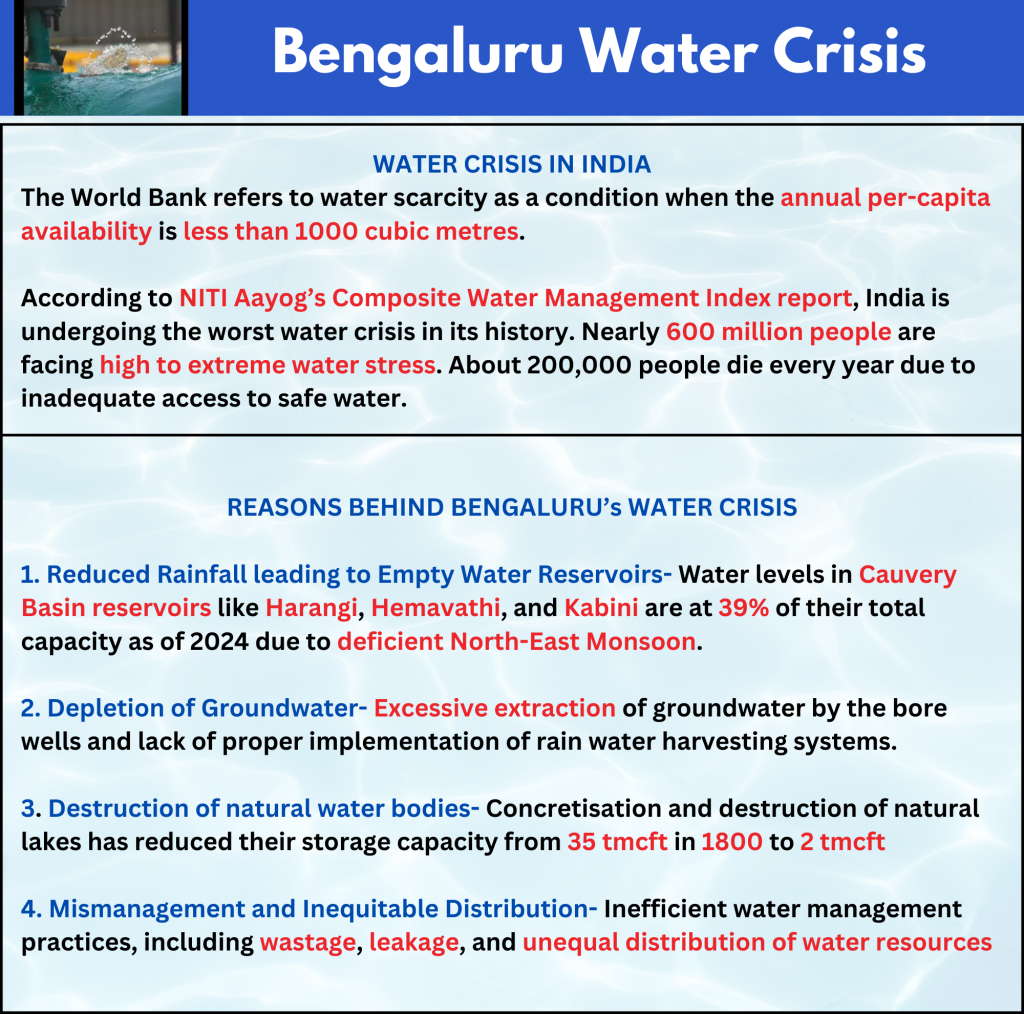The recent Bengaluru water crisis has put the spotlight again on the looming water crisis in India. Water starved Bengaluru is facing the looming threat of Day Zero (when government will shut down water connections for homes and businesses). A BBC report, based on UN-projections, had listed Bengaluru in the second position after Brazil’s São Paulo among the 11 global cities that are likely to run out of drinking water.

What is Water Crisis? What is the situation in India?
Water Crisis- Water crisis refers to the situation where the available potable, safe water in a region is less than its demand. The World Bank refers to water scarcity as a condition when the annual per-capita availability is less than 1000 cubic metres.
Water Crisis Situation in India
| Water Crisis | 1. India possesses only 4% of the world’s freshwater resources, despite supporting 17% of the world’s population. 2. A/C NITI Aayog’s “Composite Water Management Index (CWMI)”, report India is undergoing the worst water crisis in its history. Nearly 600 million people were facing high to extreme water stress. 3. India’s annual per capita availability of 1,486 cubic meters in 2021 is in the water stress category (less than 1700 cubic meters). As per Govt estimates, this may reduce to 1,341 cubic metres by 2025 and 1,140 cubic metres by 2050. |
| Lack of Access to Safe Drinking Water | According to NITI Aayog CWMI Report a. 200,000 people die every year due to inadequate access to safe water. b. 75% of the households in the country do not have access to drinking water. c. 40% of India’s population will have no access to drinking water by 2030. |
| Overexploitation and pollution of Groundwater | 1. India is the largest groundwater user in the world, with its total use exceeding 25% of the global usage. 2. Nearly 70% of Ground water is contaminated. India is placed at the rank of 120 among 122 countries in the water quality index. |
What are the reasons for the Water Crisis in India?
1. Rising water demand- According to NITI Aayog, India’s water demand is increasing at a rapid rate. India’s water demand will be twice the available supply by 2030. Also, the rate of depletion of groundwater in India during 2041-2080 will be thrice the current rate.
2. Groundwater use for agriculture – There is high groundwater usage in agriculture due to faulty cropping patterns. For ex- Water-intensive paddy cultivation in the states of Punjab and Haryana.
3. Encroachment of Natural Water Bodies- There has been destruction of lakes and small ponds to meet the infrastructure needs of burgeoning populations. For ex- Encroachment of lakes in Bengaluru.
4. Climate Change- Climate Change has led to erratic monsoon and reduced water levels in many rivers. This has induced water crisis in India.
5. Discharge of Pollutants- There has been contamination of groundwater resources by the discharge of industrial chemicals, sewers and improper mining activities.
6. Lack of proactive management policies- Water management policies in India have failed to keep pace with changing demands of time. For ex- The Easement Act of 1882 granting groundwater ownership rights to the landowner leading to indiscriminate use of water resources.
7. Governance issues-
a. Water governance in India has been fragmented. The centre and the states have their respective departments for governing various issues related to water.
b. There have been separate departments for surface water and groundwater. Central Water Commission (for surface water) and Central Ground Water Board (for groundwater).
c. Politicization of inter-state disputes by the political parties have hindered the quick resolution of disputes.
8. Detached Citizens- Since water is a free resource, it is not valued by the citizens. Citizens are completely detached from the water issues.
What are the impacts of Water Crisis in India?
1. Economic Impact-
a. As per World Bank, India’s GDP could decline by as much as 6% by 2050 due to water scarcity.
b. Water scarcity will result in decline of food production. This will hamper India’s food security and have serious impacts on the livelihood of farmers and farm labourers.
c. Decline in industrial production as Industrial sectors such as textiles, thermal power plants,etc. may suffer due to water shortage
2. Ecological Impact
a. Water scarcity may lead to extinction of flora and fauna.
b. Heavy metal contamination (Arsenic, cadmium, nickel etc.) and oil spills in rivers and oceans respectively may threaten the marine biodiversity.
3. Social Impact
a. Deterioration of health of children due to intake of contaminated water. It leads to a reduction in human capital.
b. The increased out-of-pocket expenditure on medical expenses adversely impacts the poorest and the most vulnerable sections.
c. Increased hardships for women like school dropout,’water wives‘ to fetch water in drought prone regions.
4. Federal Relations-
a. Amplification of the existing inter-state water disputes like Kaveri, Krishna, Godavari. There will be emergence of new disputes in the future.
b. There will be a rise in parochial mindset and regionalism among states and may hinder growth of national unity.
5. International Relations- Water scarcity can lead to conflict among nations to get control over the water bodies. For ex- Impact on India-China relations due to Chinese building of dams over Brahmaputra river.
What are the government initiatives?
| Jal Shakti Abhiyan (JSA) | It was started in 2019 as a movement for water conservation, recharge, and rainwater harvesting in 256 water-stressed districts. The JSA now covers all 740 districts in the country. |
| Atal Bhujal Yojana | The programme lays emphasis on the recharge of groundwater resources and better exploitation of the groundwater resources. |
| Amrit Sarovars | Centre has decided to build 50,000 water bodies (Amrit Sarovar), with an approximate area of one acre, across the country for water conservation. |
| Nal Se Jal Scheme | The scheme ‘Nal se Jal’ was started to ensure piped drinking water to every rural household by 2024. It is a component of the government’s Jal Jivan Mission. The nodal agency of the scheme will be Jal Shakti Ministry. |
| Namami Gange program | It is a comprehensive program with twin objectives of effective abatement of pollution in Ganga (Nirmal Dhara), conservation and rejuvenation of Ganga (Aviral Dhara). |
| Jal Shakti ministry | Jal Shakti Ministry has been formed by merging the Ministry of Water Resources, River Development and Ganga Rejuvenation and the Ministry of Drinking Water and Sanitation. Its aim includes-providing clean drinking water, implementing the Namami Ganga project, resolving the inter-state water disputes, cleaning Ganga. |
| National Water Policy | The policy focuses on the conservation, promotion and protection of water. It promotes measures like rainwater harvesting for meeting the demand of water. |
What should be the Way Forward?
1. Promotion of Water Conservation- Encouraging rainwater harvesting to capture monsoon run-off. Also, traditional water conservation practices like Kudimaramath practice (Tamil Nadu), Ahar Pynes (Bihar), Bamboo Drip irrigation System(North-East) must be revived.
2. Demand-side Management- States can adopt a participatory approach with the involvement of local communities. For ex- The Swajal model adopted by Uttarakhand focussing on community-based management of water resources. Revival of Johads in Rajasthan desert by Rajendra Singh (Waterman of India).
3. Nature-Based Solutions- Nature-based solutions refer to the solutions that mimic natural processes to provide human, ecological and societal benefits. For ex- Artificial Floodplains to increase water retention, Forest management to reduce sediment loadings.
4. River Basin Management- River basin management must be done through hydrological-basin approach rather than administrative boundaries. Also, steps must be taken to promote interlinking of rivers, while addressing its environmental concerns.
5. Evidence-based policy-making- We must create robust water data systems with real-time monitoring capabilities. For ex- Andhra Pradesh’s online water dashboard for mapping of hydrological resources for better policymaking.
6. Implementing the Mihir Shah Committee Report- The Mihir Shah Committee recommendations must be implemented for restructuring the water governance in India:
a. Establishing National Water Commission by merging Central Water Commission(CWC) and Central Groundwater Board(CGWB). It would ensure that the surface and the groundwater are taken as a single entity.
b. Focussing on management and maintenance of dams rather than construction of dams.
c. Adopting a participatory approach to water management.
| Read More- The Times of India UPSC Syllabus- GS 1- Issues related to water resources (Geography), GS 3- Environment |
Discover more from Free UPSC IAS Preparation Syllabus and Materials For Aspirants
Subscribe to get the latest posts sent to your email.





